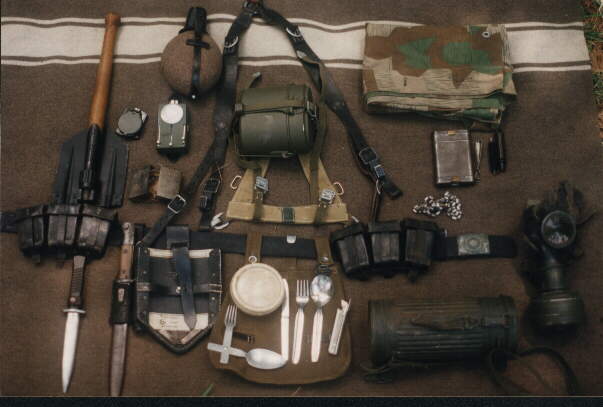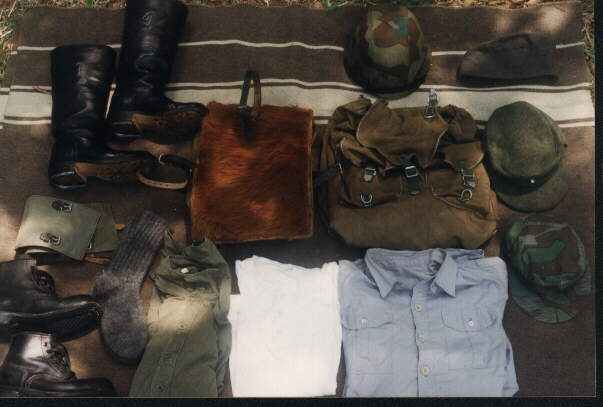Uniforms and Equipment Page
 A photo of yours truely in shirt and tie. The wearing of
the breast eagle on the shirt is against Heer regulations but quite common.
A photo of yours truely in shirt and tie. The wearing of
the breast eagle on the shirt is against Heer regulations but quite common.

 Equipment list for photo 1 is:
Equipment list for photo 1 is:
- Folding shovel and cover. The folding shovel started to
replace the straight one around 194?. There are two types of
carriers for the shovel, the type II is shown.
- Cartrage pauches, Front line troops should have two, others
one. These are late war with rivets on the front. The earlier
ones are stitched and thus easier to repair.
- The belt and buckle. The belt should be rough side out. The
buckle was made in both steel and aluminum.
- Trench Knife. A nice addition to your kit not required.
- Bayonet,sheath and frog. German soldiers are required to have
a side are, either bayonet or pistol.
- Bread bag. Colors range for tan to olive green. It should
have two D-rings (one is hidden in the photo by the lard dish).
- Eating utinsals. There are two basic pattern. The spoon fork
combo is nice. The four piece includes a can opener (this one is
post war and not quite the same pattern but close).
- Lard dish. Used to carry lard, butter, marmalade. I keep
peanut butter in mine.
- Gas mask cannister: There are two patterns 1936 and 19??.
The Spanish cannister is NOT close enough. I do not carry a mask
by the way, I keep first aid items in the can.
- Cleaning kit for the rifle. It includes a chain, brush, oiler
and take down tool.
- Zeltbahn. A must, it doubles and a tent and pancho. The
come in both canvas and gaberdean. The canvas seems to work
better. If you plan to sleep out spend the money and get one in
good shape.
- Mess tin.
- A-Frame pack. Hooks to the y-strapes, usefull for carring a
few large items. Not pictured is the A-frame bag. This will let
you carry a few personal items, but it is very small.
- Y-Strapes. These hold your belt up and have D-ring
attachements for the A-frame or a ruck sack. Austrian Y-strapes
can be converted and are ok but repro ones are not too expensive
and are better looking.
- Field Flask. Original ones are nice but early post war a
identical. The cup in the picture is plastic (which is OK) there
is also a larger metal cup with folding handles. The cover is�wool but some original ones have wood fiber that looks like
plastic.
- Flashlight. There are many patterns for these. This one is
post war East German and has been converted to 4 AA bateries.
There are three colared lenses that can be slide up and down
using the buttons on the front (red, green, blue). It also has
two leather strips at top and bottom that can be buttoned to your
uniform.
- Compass. Another of those rarely used items that looks good.
Like most items there are numerous patterns. This one is post war
but by the same company that made them during the war.
- Esbit Stove. Good for warming up coffee or maybe food. The
only pictures I have seen of them have a straight edge. However
I have been told that the post war model with the interlocking
zig zag edges are also correct. I cannot verify this but
considering the variations you see in other equipment it is
possible.

- Marching Boots. Leather sole and heel. East German boots
are ok but often have a vinyle sole. It cost me about $25 to get
the heel and sole replaced with leather on mine but they look
good now. The boots in the picture are custom made and rather
exspensive. Pebble grain is ok.
- Leggings: These are conversions of post war.
- Low boots. Came into use in 1943 to save on leather use.
not as useful as the marching boot. These are post war Belgan.
- Socks. Any basic grey wool sock will do. The German ones
have size rings in white at the top. 1=small, 2=med. 3=large.
- Knit shirt. No pockets, buttons down about half way. This
is a post war shirt.
- Cotton. Light cotton shirt with pressed paper buttons,
pleated pockets and tabs for the shoulder boards.
- 1943 Fledmutz in splinter camo reversable to white.
- Standard 43 feldmutz.
- 1934 or 1936 feldmutz depending on who you ask. This is a
sign of a vetran in 1944-5 period.
- Stallhelm. There are several pattern of these. The Spanish
ones are not exceptable and the liners of them are cheap anyway.
The camo covers were common in late 42 onward. Probably only
issued to first line combat troops.
- Rucksack. Again there are numerous models from the very
simple artillery ruck to this model (which is home made).
Originals are common and very useful.
- 1934 Pack. Not as usefull as a ruck but more common early
in the war.
43rd Sturm PioneerGo Back to the Main 43rd Page
 A photo of yours truely in shirt and tie. The wearing of
the breast eagle on the shirt is against Heer regulations but quite common.
A photo of yours truely in shirt and tie. The wearing of
the breast eagle on the shirt is against Heer regulations but quite common.

 Equipment list for photo 1 is:
Equipment list for photo 1 is:
